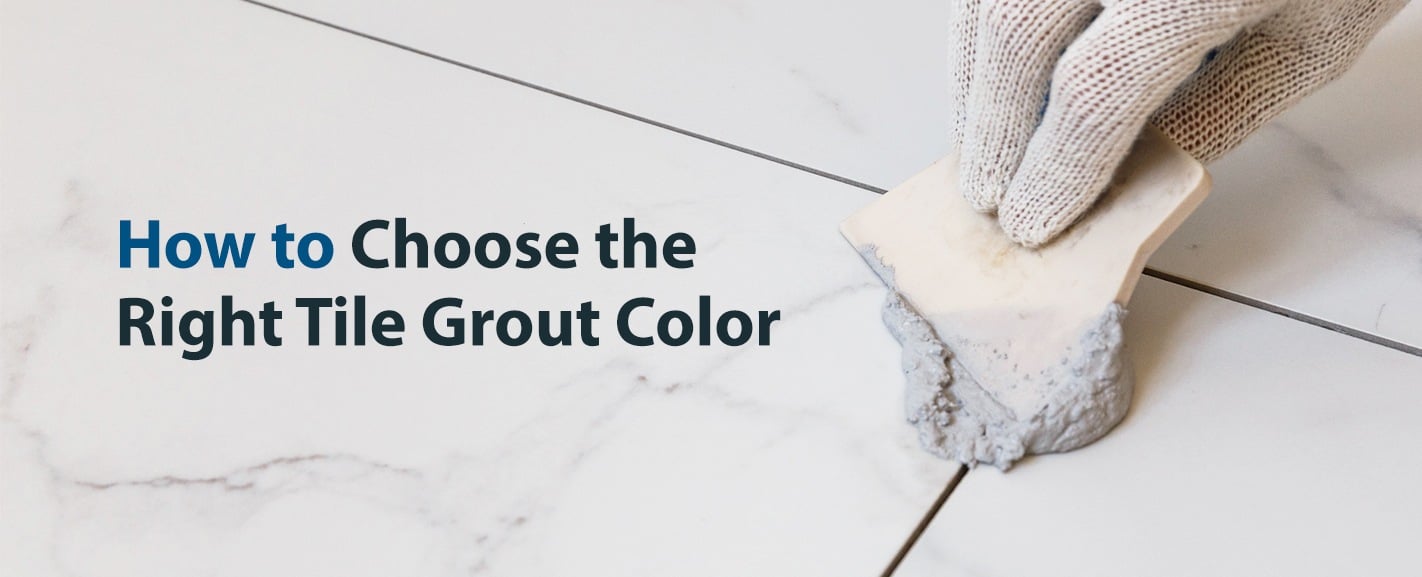

When you look at the floors in your home, it’s probably apparent that tile can have a big impact. Entering a room with white marble tile is going to be a radically different experience from entering one that’s completely covered in dark green tile. When the time comes to replace that tile, you’ll no doubt know to consider those factors.
But what you might not consider is that the grout is equally important. Though it takes up significantly less of your floor space, it still has an impact on the eye, one large enough to determine the feel of an entire room.
What Is Tile Grout and Why Is It Important?
To start with, it acts as a sealant against water. You have to space the tiles apart to keep them from cracking in case they expand, but leaving those gaps empty would allow water to seep down into the floor and cause damage. Grout keeps that from happening but also serves a visual purpose.
As important as the tiles are, the grout between them has the power to set them apart or blend them together. Much of this is dependent on the grout color. There are three ways that grout can relate to the tile it borders — matching, complementing or contrasting.
Relating Grout to Tile
Grout color plays a vital role in bringing a room together. How you choose to blend colors or manipulate color palettes can enhance your spaces or create a visually unappealing space. When considering how to relate grout color to tile flooring, there are three methods you can choose:
- Matching: Matching grout is the same color, or very nearly so, as the tile.
- Complementing: Complementing grout is a different color than the tile, but only subtly, often using neutral colors.
- Contrasting: Contrasting grout involves using a radically different color than the tile, like white tile with black grout.
Each of these arrangements has a markedly different effect on the tile, and therefore on the overall look of the room.
Matching Tile Grout Colors
Matching grout can create an open, seamless space. This method allows the grout to fade into the background to make way for other visually appealing aspects of your room or floor.
For example, if you choose a multi-colored pattern for your tile, having grout that coordinates with one of the colors within the pattern will enable you and your guests to admire the design without being overwhelmed by the grout. The grout will blend with the edges of the tile and create a cohesive pattern, whether working with one color or many.
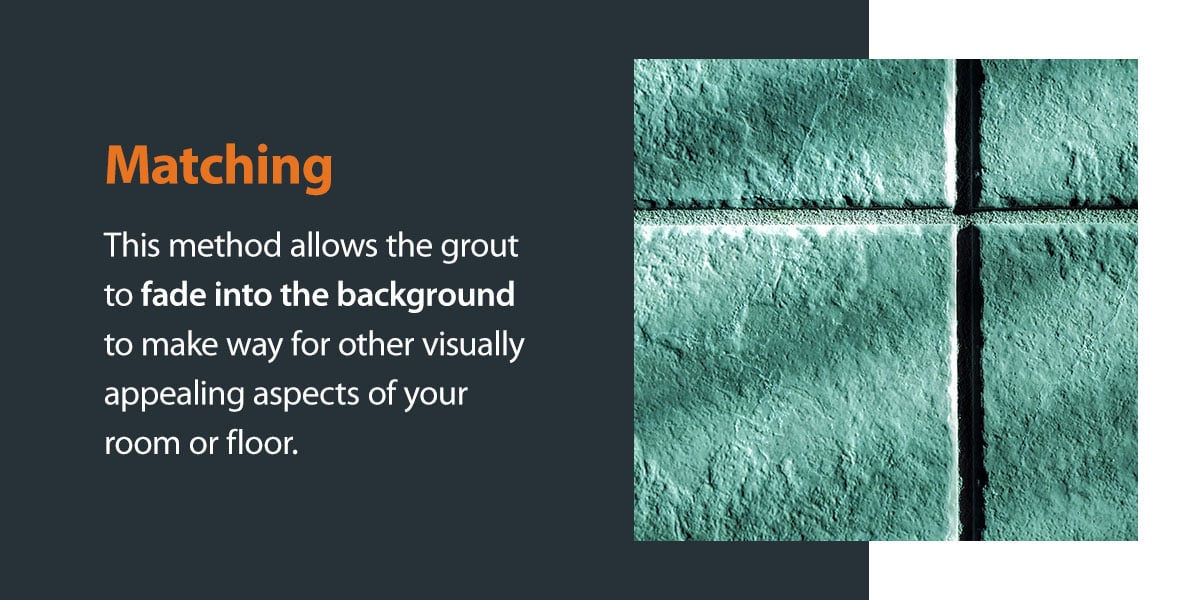

Complementing
Complementary colors sit on opposite sides of the color wheel. Pairing diametrically opposite colors with your interior designs can be challenging, but it offers uniqueness and playfulness. You can create energetic spaces in areas like the kitchen or bathroom with color pairings like blue and orange or yellow and purple.
Contrasting
Contrasting grout can be an excellent way to draw attention to unique non-linear spaces or patterns, such as stone. Contrasting your tile grout is a smart approach if you want to add bold colors to your home.
Navy blue tiles and off-white grout or sliver glass tiles with dark red grout can highlight your style and create interesting spaces. As a bonus, dark grout typically needs minimal maintenance, so choosing a light tile and dark contrasting grout can create a more lasting visual draw in a room.
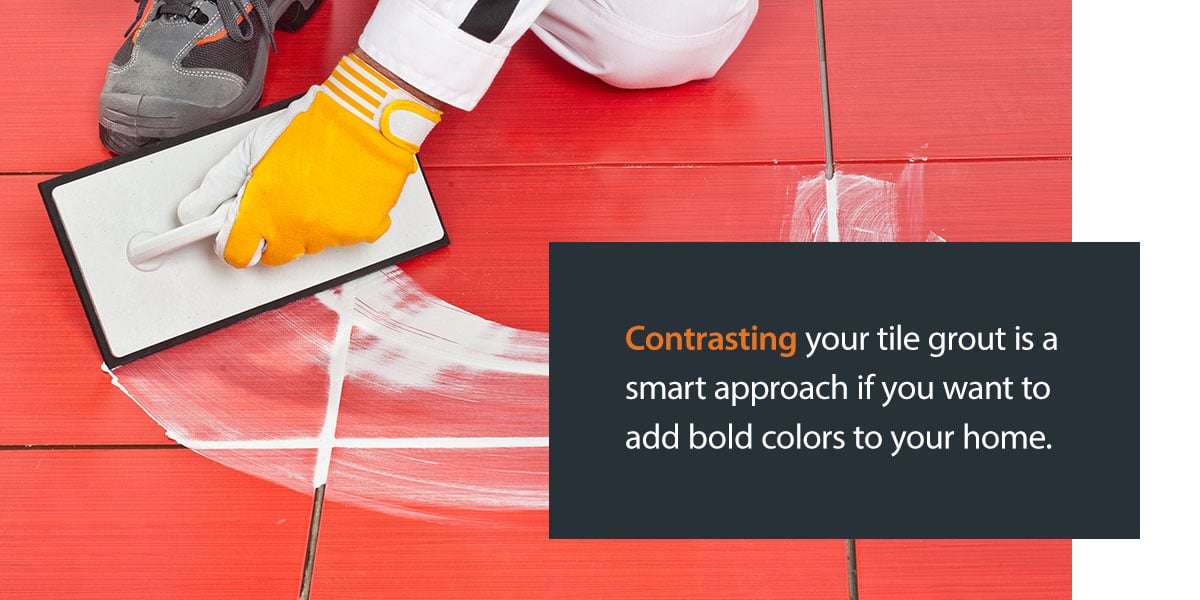

Common Tile Grout Colors to Choose From
Wall and floor colors can vary dramatically across different homes and rooms, but it’s interesting to note that the range of colors is largely dependent on the materials used. Rooms whose walls are covered in wallpaper or paint, for example, tend to use bold colors like red and bright blue more often than those covered in tile.
By the same token, there’s typically more room for color variety amongst the tiles themselves than amongst the grout. Grout can certainly contrast with the tiles it borders, but in most cases, it would look rather strange to walk into a room with bright red grout, no matter what color the tiles were.
Most often, grout comes in simple, earthy colors. White and black are two of the most common tile grout colors. Shades of gray, brown, beige and mossy green are also popular choices. There are even more colors available, depending on what you need.
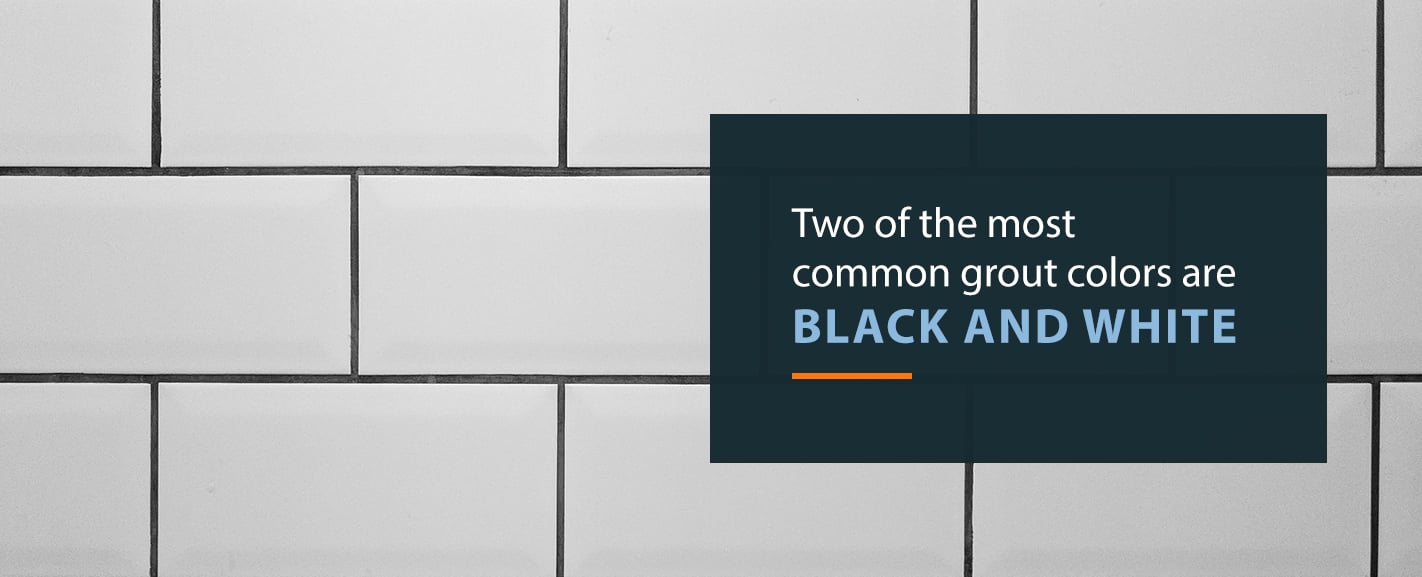

Tips on How to Choose Grout Color
Choosing grout color isn’t always an easy process. It becomes more complex when you consider more than just what color you like best when you look at the available options. You have to consider how the grout color will compare with the tile color, as well as what it will mean for installing and cleaning.
Believe it or not, the color of your grout can have an impact on how you apply it and on how much you have to clean it later on. The good news is that if you’re aware of these factors when you choose the grout, you can make sure you know exactly what you’re signing up for. Here are some things to consider when deciding what color grout to use:
1. Apparent Size
It may seem strange, but grout can affect how big a room feels. If you walk into a room that uses complementing or matching grout colors, the grout will make all the tiles feel connected, giving off the feel of a wider floor.
Contrasting grout, on the other hand, makes the space feel more active and full. If you’re more comfortable in smaller spaces, contrasting might be the way to go. Otherwise, consider matching or complementing colors.
2. Pattern
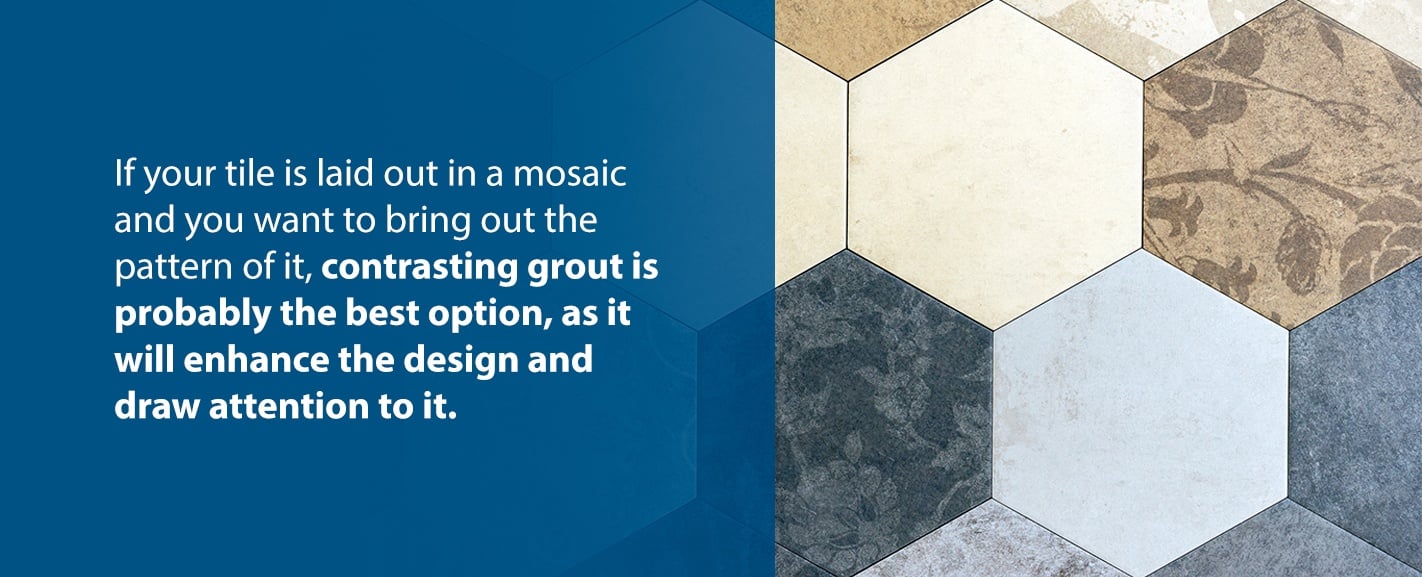

Another thing to think about is what the design of the tile is intended to be. If you want a simple grid, like subway tile, you can go either way. But if you lay out your tile in a mosaic and want to bring out the pattern, contrasting grout is probably the best option because it will enhance the design and draw attention to it.
3. Stains
One danger to using dark grout is that it can stain light-colored tiles. If you want to install that particular combination, be sure to apply a sealant to your tiles before you apply the grout. Test the sealant beforehand to make sure it will be effective.
4. Cleaning
Darker shades of grout may be more of a pain to install, but they can save you trouble down the road. That’s because floors are natural spots for dirt to accumulate, particularly in high-traffic areas. As grout is usually slightly below the level of the tiles, it’s hard for mops and vacuums to clean those depressions out well.
If you have light-colored grout, this arrangement will make things harder on you, as you’ll have to clean it more frequently and more extensively. Dark grout, on the other hand, makes it harder to see dirt. It’s still good to clean it sometimes, but it requires much less effort than lighter grout. Be aware of this factor, especially if you’re putting the grout on a floor people will frequently walk across.
5. Color Change
If you’ve ever painted a wall and had it dry into a different shade than it looked like when it was wet, you’ve already had experience with one potential aspect of grout. Like some brands of paint, grout can occasionally come out looking different than you expected after it dries. In some cases, this change might throw off the effect you were trying to create.
When this happens, don’t worry — you still have options. In particular, you can take advantage of staining products to recolor your grout. Be aware, though, that these products are best for making grout darker, not making it lighter.
So if you’re looking for a particular color and you’re unsure of which shade to pick, it’s better to err on the side of too light a grout rather than one that’s too dark. You can always darken it later.
6. Sealing Grout
Roughly a week after your grout has been put in, you’ll want to come back for a final step — sealing. Sealing your grout will help cut back on how much it gets stained down the line. The type of sealant you use depends on the tile and grout you have. Some are better for ceramic tile, while others work well with marble. Likewise, certain sealants are more suited for sanded grout, which is typically used in wider tile spacing, while others are best for non-sanded grout, which is used in tighter spacing.
Once you’ve selected the best sealant, apply it slowly and diligently to your grout, making sure to wipe up any excess as you go. After you’ve applied the sealant, leave it for around an hour, and then apply a second coat. Give it one to two days to settle in, avoiding foot traffic in the area during that time.
Tile and Grout Color Combination
You have free reign to choose the best colors for your home, but we’ve noticed some popular trends making their way into living spaces. Here are some grout color ideas for your home that can enhance your look and create unique areas you’ll love:
Low Contrast
Low-contrast grout can create a timeless and warm feeling for your room. For instance, black grout with matte black tile for a kitchen backsplash can create a texture that blends well with many decorations and color combinations. This look is more of a simple stylistic choice that can enhance your space.
Gray Grout
Gray grout is a popular choice because it can create an array of designs and meet many homeowner needs. Fresh gray grout can build modern spaces and provide subtle depth. For tiles with many textures or patterns, gray grout can fade into the background and reduce visual clutter.
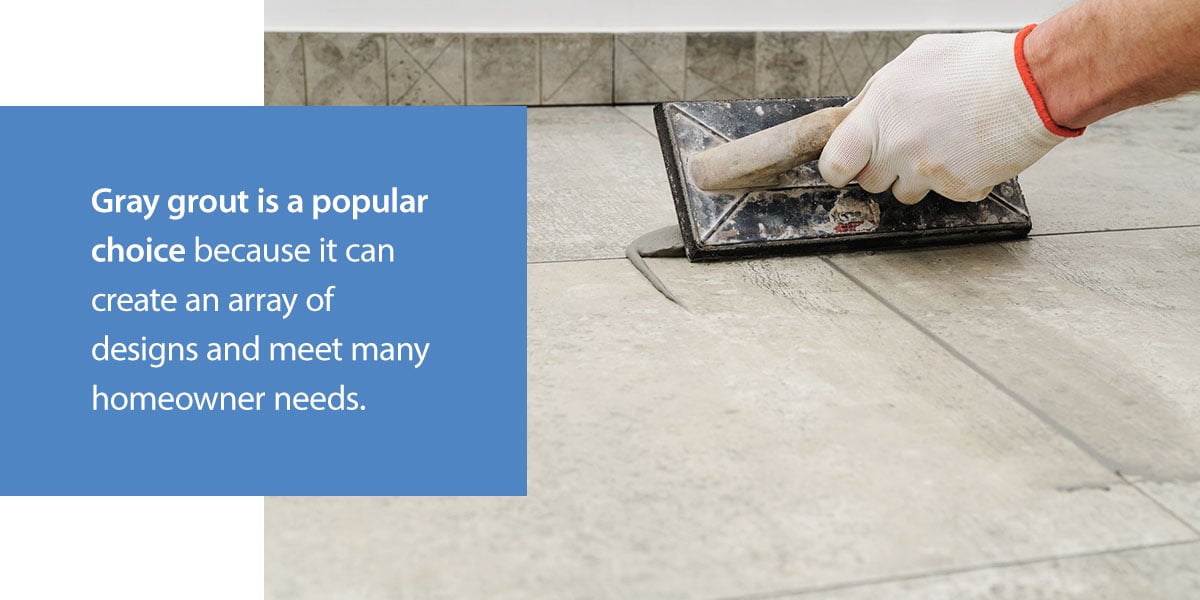

Brass Inlay
Brass can quickly transition a dull space to a sleek and modern area that evokes sophistication. Brass inserts are especially beautiful with marble tiles, amplifying the texture and design. For backsplashes and floors, brass is a showstopper you’ll love.
Thick Lines
Regardless of your chosen color combinations, thick grout is making its way into homes. This stylistic choice feels purposeful and stately, empowering you to grab attention and keep it. You can highlight contrasting colors or utilize your go-to color combination and still manage to personalize your space with thick grout lines.
Understanding Tile Grout Options: Compositions and Ratings
Compositions of Tile Grout
Tile grout comes in various compositions to cater to different tiling needs. Among the available options, you will primarily find:
- Powder Grout: This is the most common type, offered in three different formulas.
- Single Component Grout: This option is pre-mixed, making it easy to use right out of the container and is available in one primary formula.
Ratings of Tile Grout
To ensure you choose a product that meets your expectations in terms of quality and performance, tile grout options are rated as follows:
- Good: This rating is assigned to two of the tile grout options, indicating a satisfactory level of quality and performance for standard applications.
- Better: One of the grout choices holds this rating, suggesting a higher quality and improved performance characteristics.
- Best: There is also one grout option that achieves the top rating, designed for those who seek the highest quality and best performance in their tiling projects.
When selecting tile grout, understanding these compositions and ratings can help guide you to the best choice for your specific project needs.
Schedule Your In-Home Tiling Appointment
If you’re looking at picking a grout color for your tile floor, you’re likely installing or replacing the tile floor altogether. It can be challenging to know what tile and grout colors will look best in your home when the only place you can see them is in a store.
Thankfully, you don’t have to go to a store to view your options. 50Floor offers a “shop-at-home” experience, where we bring tiling and grout options right to your home. This process lets you see them in the room of your choice before deciding, so you can be sure you’re getting the right color. Schedule an appointment with us today to get started!
Frequently Asked Questions
What Are the Advantages of Using Epoxy Grout Over Traditional Grouts?
Epoxy grout presents numerous advantages over its traditional counterparts, making it a compelling choice for many tiling projects.
Here are the key benefits:
- Ease of Use and Maintenance: Unlike traditional grouts, epoxy grout is straightforward to apply and wipe clean. This feature simplifies the installation process and reduces the overall time spent on the job.
- No Sealing Required: One of the notable conveniences of epoxy grout is that it does not require sealing. This omission saves on both the cost and labor typically involved in the additional sealing step necessary with other grout types.
- Consistency in Color and Appearance: Epoxy grout maintains consistent color and does not fade or discolor easily, ensuring that the aesthetic integrity of your tiling remains intact over time.
- Durability and Hardness: Epoxy grout is remarkably durable and forms a hard, dense bond that stands up well to traffic and usage. This makes it an excellent choice for areas that endure high wear and tear.
- Superior Stain and Water Resistance: The composition of epoxy grout offers excellent resistance to water and stains. This quality makes it ideal for areas prone to moisture, such as kitchens and bathrooms.
- Ideal for Various Surfaces: It is particularly suitable for delicate surfaces like natural stone and polished tiles, providing strong adherence without compromising the tile’s appearance.
Despite its relatively higher price point and longer curing time, the robust features of epoxy grout offer significant long-term benefits, making it a worthwhile investment for both residential and commercial tile installations.
What is the Importance of Choosing the Right Grout for Tile Installations?
Selecting the ideal grout for your tile is more crucial than it might initially appear. Imagine investing significantly in luxurious, polished porcelain tiles that mimic the grandeur of real marble. These tiles are much like purchasing a masterpiece for your home—a comparison akin to acquiring your very own Mona Lisa.
Why Grout Matters
Grout does much more than merely fill spaces between tiles; it frames them, enhancing their appearance and ensuring durability. Don’t settle for low-quality grout, just like you wouldn’t use a cheap, poorly-fitting frame for a priceless painting. Choosing inappropriate or low-quality grout can lead to unsightly results and even damage your tiles.
Making the Right Choice
- Aesthetic Cohesion: The right grout color and type can complement your tiles, pulling the entire look of a room together seamlessly.
- Protection: Quality grout acts as a barrier against water and dirt, preventing under-tile moisture that can lead to mold growth and structural damage.
- Longevity: Properly chosen and applied grout can extend the life of your tile installation, avoiding the need for frequent repairs.
Grout plays an indispensable role in both the appearance and longevity of tile installations. It’s crucial to select the right type not just for aesthetic harmony but also to ensure that your tiling remains beautiful and intact over time. Investing in good grout is investing in the longevity and effectiveness of your entire tiling project.



